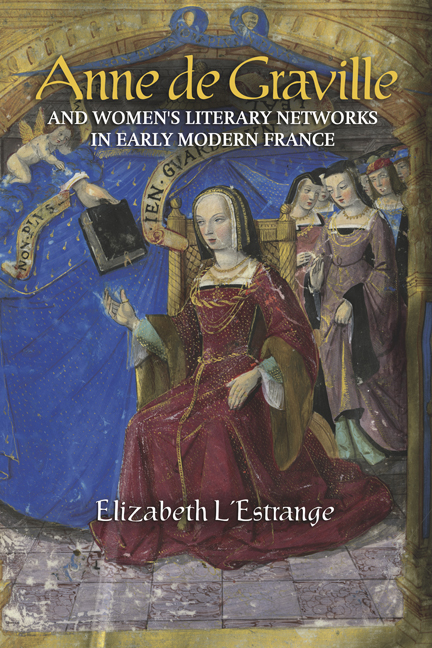Book contents
- Frontmatter
- Dedication
- Contents
- List of Illustrations
- Acknowledgements
- A Note on Citations, Translations and Transcriptions
- List of Abbreviations
- Map
- Introduction: ‘Une femme d’excellence en vertus, ma dame d’Entraigues’: Anne de Graville’s Life and Works
- PART I ANNE DE GRAVILLE: READER AND COLLECTOR
- PART II FROM READING TO WRITING: ANNE AS AUTHOR
- Conclusion: ‘Celle la qui porte le regnon’: A Last Word on Anne de Graville
- Appendix A Books Inherited, Acquired, Commissioned by or Associated with Anne de Graville
- Appendix B Inventory of the d’Urfé Library at La Bâtie, c. 1780
- Appendix C Manuscripts Containing Works by Anne de Graville
- Bibliography
- Index
- Gallica
6 - Debating with ‘Maistre Allain’: Chartier, Blois and Poetic Form in the Rondeaux for Louise of Savoy
Published online by Cambridge University Press: 11 January 2024
- Frontmatter
- Dedication
- Contents
- List of Illustrations
- Acknowledgements
- A Note on Citations, Translations and Transcriptions
- List of Abbreviations
- Map
- Introduction: ‘Une femme d’excellence en vertus, ma dame d’Entraigues’: Anne de Graville’s Life and Works
- PART I ANNE DE GRAVILLE: READER AND COLLECTOR
- PART II FROM READING TO WRITING: ANNE AS AUTHOR
- Conclusion: ‘Celle la qui porte le regnon’: A Last Word on Anne de Graville
- Appendix A Books Inherited, Acquired, Commissioned by or Associated with Anne de Graville
- Appendix B Inventory of the d’Urfé Library at La Bâtie, c. 1780
- Appendix C Manuscripts Containing Works by Anne de Graville
- Bibliography
- Index
- Gallica
Summary
Anne de Graville's reworking of Alain Chartier's Belle dame sans mercysurvives in one vellum manuscript copy now Paris, BnF, ms fr. 2253. The text was written by two different scribes, the first of whom was also responsible for the Chantilly copy of the Beau romanas well as the prologue in Anne's copy, fr. 25441. There is no illumination, or provision for miniatures, but alternating gold-on-red and gold-on-blue initials and paragraph marks punctuate the verses of Anne's rondeaux, which occupy the main part of each page, with Chartier's original huitainswritten in a smaller script in the margins. Anne's motto, j’en garde un leal, appears in a banderol beneath the prologue, which bears the title ‘A ma dame’ (fig. 52). It was on the basis of the anagram that Wahlund, in the late nineteenth century, identified the work as being by Anne, although the BnF catalogue still does not list her as the author. Logically enough, scholars familiar with the Beau roman's dedication to Claude have assumed that the Rondeauxwas also dedicated to the queen and it has traditionally been seen as the earlier work. Yet, as Chapter 5 showed, all but one of the surviving copies of the Beau romanexplicitly refer to ‘la royne [Claude]’ and the prologue refers to ‘ma souverainedame’. This difference between the two titles has never been remarked upon but in fact already pointed to the possibility that the Rondeaux's dedicatee was a lady other than Claude. The rediscovered frontispiece showing Louise of Savoy receiving a book from a kneeling woman, with the words ‘la belle dame sans mercy / translatée en rondeaulx’ on the reverse, now confirms the recipient, and certain motifs discussed below suggest that it was composed after Claude's death in 1524 (figs 6 and 53).
The Belle dame sans mercywas composed by Chartier in 1424 and was his most frequently read work. The majority of the poem consists of a debate between a lover and a lady, and this debate format would become a popular literary genre in subsequent decades, with poets frequently drawing inspiration from Chartier's work.
- Type
- Chapter
- Information
- Publisher: Boydell & BrewerPrint publication year: 2023



